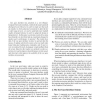592 search results - page 98 / 119 » User adaptation: good results from poor systems |
ICAC
2005
IEEE
14 years 1 months ago
2005
IEEE
Detection and diagnosis of faults in a large-scale distributed system is a formidable task. Interest in monitoring and using traces of user requests for fault detection has been o...
VRST
2000
ACM
14 years 2 days ago
2000
ACM
For virtual reality systems, modeling of 3D objects and scenes is important and challenging. In this paper, we present an image-based interactive 3D modeling framework consisting ...
GECCO
2008
Springer
13 years 8 months ago
2008
Springer
In the early days a policy was a set of simple rules with a clear intuitive motivation that could be formalised to good effect. However the world is becoming much more complex. S...
APCHI
1998
IEEE
13 years 12 months ago
1998
IEEE
Eye gaze interface has potential as a new HumanComputerInteractionmethod, evidentin the numerouskinds developed so far. However, in order to make sure that such an interface is bo...
HCI
2009
13 years 5 months ago
2009
Responsive Adaptive Display Anticipates Requests (RADAR) is a domain general system that learns to highlight an individual's preferred information displays, given the current ...

